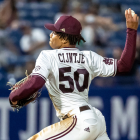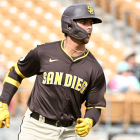On Thursday, Major League Baseball's Winter Meetings will conclude with the annual Rule 5 draft. For those unaware, the draft is a mechanism designed to prevent teams from hoarding talent, and to provide opportunities to players who may have otherwise not received them with their current organization. Eligibility for the draft is based on signing age and years of minor-league service.
Players who signed at 18 or younger and have played at least five professional seasons are eligible, as are players who signed at 19 or older and have played at least four professional seasons. All players who are on a 40-man roster are ineligible for the draft -- hence top prospects being added ahead well ahead of their debuts.
Teams pay $100,000 per selection to the player's old team, and then must keep that player on the 25-man roster for the duration of the season. If the team decides against keeping the player on the active roster all year, then the player must be sent to the waiver-wire. Should they pass through unclaimed, they then must be offered back to their old team for $50,000. (There's also a minor-league portion of the Rule 5 draft, but we're not going to concern ourselves with that.)
With that out of the way, here are 16 names worth knowing heading into the draft. Note that the players are listed in alphabetical order, as opposed to an ordinal ranking.
Brandon Bailey, RHP, Houston Astros
Brandon Bailey is the answer to a trivia question: who did the Astros receive in return for Ramon Laureano? That trade doesn't look so hot for the Astros two years later -- Laureano has since established himself as a well-above-average center fielder -- Bailey still has a chance to put together a big-league career of his own. His game is one of checks and balances. He's short (5-foot-10 officially) and doesn't throw hard or get good extension out in front. He does, however, impart good spin on his fastball and complements it with a quality changeup and breaking ball. To keep with the theme: Bailey has struck out at least a batter per inning in each of his four professional seasons; alas, he's also walked around four per nine in the past two years. If he's chosen -- there's industry buzz suggesting he will be -- his best role will likely be as a hybrid type who can run through a lineup once or twice.
Joe Barlow, RHP, Texas Rangers
Joe Barlow figures to be selected early based on his perceived upside. He's a pure power reliever, with a wide-shouldered 6-foot-3 frame, a fastball that can touch into the upper-90s, and a potentially plus breaking ball. Last season, he managed a 14.7 strikeout-per-nine rate across three levels, including a Triple-A stint. So, why is he available? Because Barlow has well-below-average command that causes his raw stuff to play down. That aforementioned Triple-A cameo saw him walk 21 batters in 17 innings, and big-league hitters don't tend to swing at pitches in the areas his pitches most frequently populate. Every team thinks it can tame a wild arm. If someone succeeds with Barlow, they'll get a high-leverage arm.
Phil Bickford, RHP, Milwaukee Brewers
The 18th pick in the 2015 draft, Phil Bickford had himself a quality season as a member of the Brewers' High-A affiliate's bullpen. He struck out more than 40 percent of the batters he faced, walked less than 10 percent for the first time in years, and continued to keep the ball in the yard despite flyball-centric ways. For as good as the stuff looks, teams have makeup concerns stemming from multiple failed drug tests. As such, Bickford might go unpicked -- even if his pedigree, results, and potential suggest he's worth a look.
Zack Brown, RHP, Milwaukee Brewers
Another Brewer farmhand, Zack Brown entered the season considered one of the organization's top pitching prospects. He had a miserable season, accumulating a 5.79 ERA in 116 Triple-A innings behind a deluge of walks and home runs. How much of Brown's struggles were on him; how much were on the altered ball; and how much were on the Pacific Coast League? Even rival evaluators have conceded they're unsure. A team willing to find out with a first-hand look could take Brown and hope that he rebounds -- if he does, he could be a back-end starter, or a potentially useful multi-inning reliever.
Thomas Burrows, LHP, Atlanta Braves
Theoretically, ready-made left-handed specialists like Thomas Burrows should have the easiest path to a solid big-league career. He's already proven his aptitude at a high level, having held Triple-A lefties to a .501 OPS last season thanks to his deceptive arm slot and quality fastball-slider pairing. Yet the potential implementation of a batters-faced minimum could threaten his utility, and his attractiveness to teams. Burrows will probably still be selected, but he might have to establish himself as a threat against right-handers if he's going to stick around.
Michael Gettys, OF, San Diego Padres
Michael Gettys has been known as a tool shed since being drafted in 2014. He has raw power, he has speed, he has a big-time arm, and he has usability issues. Even last season -- a successful one, relatively speaking -- saw him strike out in more than 30 percent of his plate appearances, or about five times as often as he walked. Sturgill Simpson probably has a better chance of becoming the best clockmaker on Mars than Gettys does of putting everything together. But his name value and potential -- however unlikely it is to be fulfilled -- make him worth mentioning. (A fair amount of this applies to fellow Padres outfielder Buddy Reed, who is also Rule 5-eligible and might be a more sensible selection.)
Cam Hill, RHP, Cleveland
Originally the 518th pick in the 2014 draft, Cam Hill hails from Redlands Community College in El Reno, Okla. -- a school that, as of this writing, has not produced a big-league player. Hill might change that thanks to a fastball that plays up thanks to a high, deep release point and a decent curveball. He hasn't thrown so many as 40 innings in a season since 2017, so there's a fair amount of injury risk. In an odd sense, that might make him more likely to be selected -- the way the Rule 5 works, it's almost easier to keep an injury-prone player than it is to keep someone who is consistently healthy.
Wander Javier, SS, Minnesota Twins
The Twins signed Wander Javier in July 2015 for $4 million. Since then, he's appeared in just 130 games due to injury. The bulk of those appearances came last season, as he took 343 plate appearances at the Class-A level. Things didn't go well. Rather, Javier hit .177/.278/.323 with more than three times as many strikeouts as walks. There's still a lot to like about him from a tools perspective, however, it's hard to see any team attempting to stash him at the end of their bench. We're listing him here for posterity's sake.
Griffin Jax, RHP, Minnesota Twins
Yup, another Twins prospect. Griffin Jax is the spiritual inverse of Javier -- rather than being a toolsy 20-year-old shortstop, he's a 25-year-old right-hander who projects as a No. 5 starter or reliever. He throws a ton of strikes and seldom walks anyone, but he also doesn't miss many bats. Though Jax is unlikely to sell many jerseys or tickets, he should get the chance to be on some team's staff come spring.
Trevor Lane, LHP, New York Yankees
Trevor Lane spent most of the season in Double-A, where he was effective against lefties and righties alike. That's notable given Lane is a smallish left-hander with a lower arm slot. He does most of his work with a low-90s fastball-curveball combination, both of which feature above-average spin and can be thrown for strikes. It's worth noting Lane made some interesting tweaks this season -- throwing his changeup more and getting better extension on his fastball.
Trevor Megill, RHP, San Diego Padres
Megill is the largest individual on our list. He's officially 6-foot-8 and 235 pounds, and he looks the part. He spent most of last season at Triple-A, where he struck out nearly 13 batters per nine innings. Rest assured, Megill's game isn't about smoke and mirrors. He upped his velocity to where he sits in the mid-90s and can touch 98 when needed -- and that's just raw velocity; he gets good extension, leading to a quicker perception. Megill also has a plus slider with good spin that is his top secondary offering. He throws more strikes than others on this list, which should put him near the top of any attentive team's board.
Shervyen Newton, SS, New York Mets
Recall what we wrote about Wander Javier a few beats above? Some of that applies to Shervyen Newton, who seems unlikely to be taken after a miserable season. Newton hit .209/.283/.330 in A-ball as a 20-year-old. He's a switch-hitting shortstop with a frame that suggests he has above-average power potential, but there's almost no chance he's selected unless a team wants to punt a roster spot.
Luis Oviedo, RHP, Cleveland
For as difficult as it is to hide a Franco or Newton type, it's a little easier to do it when the player in question is a pitcher. Just last season, the Blue Jays successfully kept 19-year-old Elvis Luciano -- albeit with some help from a lengthy injured list stay due to an elbow issue. If there is to be a Luciano to be found in this year's class, it might be Luis Oviedo, who entered the year projected as a No. 4 starter thanks to a quality fastball. Alas, Oviedo had a rough go at it in the Midwest League and bled velocity. That combination -- plus his inherent rawness -- might be enough for teams to pass on him.
Joel Peguero, RHP, Tampa Bay Rays
The Rays did a lot of 40-man roster trimming at the deadline and earlier this winter to protect as many prospects as they could. Still, a few interesting names were bound to slip through -- like Joel Peguero, a 22-year-old reliever who posted a 2.85 ERA and struck out nearly a batter per inning in A-ball. Peguero has good stuff, including a big-time fastball, but needs to continue to refine his command -- his delivery indicates he's never going to have a ton of it -- and he has a limited track record outside of rookie ball.
Curtis Taylor, RHP, Toronto Blue Jays
One of the prospects the Rays traded at the deadline, Curtis Taylor landed in Toronto through the Eric Sogard deal. He's a big righty who hasn't yet pitched for the Blue Jays organization due to arm woes. When healthy, he has a good fastball-slider pairing that should make him a useful middle reliever. The Rays used him in a hybrid role in 2018, so it's even possible he could pitch multiple innings if asked.
Eli White, UTL, Texas Rangers
We'll end with Eli White, who should appeal to teams as a cheap utility type. The Rangers acquired White from the Athletics as part of the Jurickson Profar trade last winter, and he spent the season in Triple-A, where he hit .253/.337/.418 while splitting time between center and shortstop. His bat might be a little light to start -- he doesn't offer much pop and he strikes out a fair amount -- but his versatility should make him an appealing end-of-bench target for thrifty clubs.


















